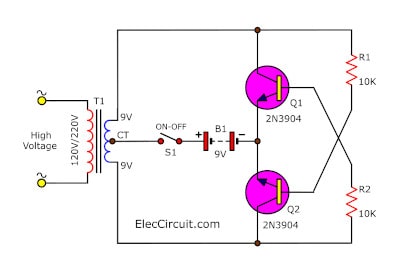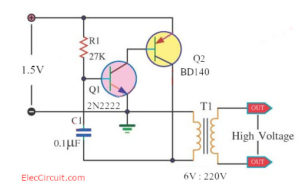The AC output frequency of a power inverter device is usually the same as standard power line frequency, 50 or 60 hertz. An ideal power inverter should generate accurate 230V AC 50 Hz or 110V AC 60 Hz power with sine wave waveform. A less ideal inverter typically generates square wave or “modified sinewave” waveform at around those frequencies.
There are many different types of inverters. There are also some inverter designs that works on other frequency. They can work on some applications and are unsuitable for some other applications. The inverters that work on other than mains frequency are often to used to drive energy-saving lamps and can work on some loads. This type of inverters can be non working with transformers, motors and some LED bulbs. Non-working can mean in best case that it just simply does not works and on some cases can mean damaged equipment (either inverter or load).
Free-running transistor inverters
The PUSH-PULL DC-AC INVERTERS describes a free-running converter called Royer oscillator. The main drawbacks of this circuit are unstable frequency, square wave output, lack of voltage regulation. The operating frequency is dependent on transformer characteristics and can vary when the connected load or supply voltage varies.
There is also a simper variation of this that needs less primary coils on the transformer.Small High Volts shock using 2SC1815 transistor web page describes a small high volts shock circuit. It uses alternation of Q1 and Q2 can make be the electric current alternates to come out at coil secondary coil.
I have built this type of circuits years ago for various applications in mind with varying success in getting the output I expect to get. Top 3 Inverter Circuits…Simple Inverter Circuits video shows also one circuit version.
One transistor inverters
There are also one transistor circuits that have been published to Internet:
Video 100 watt inverter 12 volt to 220 volt AC at
https://www.youtube.com/watch?app=desktop&feature=youtu.be&v=JHOGTw3eN6Y. It might generate some output, but I doubt that it could properly handle 100W.
How to make 1.5V to 220V inverter circuit page shows a mini high voltage generator that is claimed to give 220V from 9V batteries and give pulse voltage tall arrive at 170V from the 1 dry cell (1.5V).
High frequency output inverter issue
Inverters and converters with large power output capabilities are presently being operated at frequencies above the audible band. The advantages of reduction in size and the elimination of audible noise have given designers the incentive to increase the frequency of operation of inverters.
500 Watt 12V DC to 220V AC converter video features a high frequency output inverter from banggood):
500W DC 12V 16V To AC 18V 0-220V-380V DC To AC Inverter Boost Board Step Up Power Module Converter Transformer High Energy Efficiency Long Life Low Power Consumption Energy Saving
Specifications:
Power: 500W
Input: DC 12V
Output: AC 0-220V-380V and AC 18V
Static load current: about 0.35A
Output frequency waveforms: about 20KHZ, high frequency square wave
According to description this this product it gives square wave at about 20KHZ frequency. That kind of frequency might work with some few originally mains powered devices, but not with many. It might works with traditional light bulbs, resistive loads, some energy saving bulbs and maybe with some switch mode power supplies. But it does not work with inductive loads like traditional transformers or motors (so you should not connect with AC 220v fan).
They have a cheaper similar type module:
150W Converter DC 12V to AC 220V Inverter Boost Module Step Up Board
Features:
Power: 150W
Input voltage: DC12V
Output voltage: AC 0-110V-172V-200V-220V
Quiescent current: about 0.05A
Output waveform: high frequency square wave
Output frequency: about 20KHZ
Protection: None
https://www.banggood.com/150W-Inverter-Boost-Module-150W-DC12V-Step-Up-Board-Frequency-Square-Wave-p-1278570.html?rmmds=detail-left-hotproducts__3&cur_warehouse=CN
https://www.banggood.com/150W-Converter-DC-12V-to-AC-220V-Inverter-Boost-Module-Step-Up-Board-p-1278573.html?rmmds=search&cur_warehouse=CN
Another lower power model with some instructions:
40W DC-AC Inverter Power Supply 12V Liter 220V Step Up Transformer Boost Module Support in Parallel
Feature:
1. Output DC and AC dual output, can output DC and AC voltage, fully compatible with all kinds of electric appliances
2. Without connecting wires, you need to solder the input and output wires yourself.
3. Instructions for use: This product can convert the DC power of 8V-13V battery into 220V AC power for household use, and DC output dual output.
4. This product is the latest 4 generation booster module and step-up transformer. Input 12V DC, the other end can get 220V AC, and 220V DC voltage. The frequency is high frequency and the output power is larger, which can drive 40W energy-saving lamps.
5. Best fit 220V actual power consumption 0.1W to 40W energy-saving lamps! Compatible with 21W-50W energy-saving lamps; brightness is about 40W after startup!
6. Product use voltage DC12V: Inverter output voltage AC220V maximum power output 36 watts; actual power consumption 40W!
7. Can be used for household appliances within 40W; low power; can be used in parallel; automatically change current!
8. Note: Please test the output voltage with load, and it is easy to burn the voltmeter with no load.
9. Power available: AC220V 0.1W-40W
As you can see this kind of high frequency output inverters aver very limited in which applications they can be used. They might work on some applications where you can control what is connected to them end you know for sure that the load can handle what the inverter gives out. Connecting a wring type of load to this kind of high frequency inverter can fry the load and/or the inverter circuit.
For example if you connect a LED light bulb that uses capacive voltage dropper circuit, expect the bulb to be fried soon when connected to considerably higher frequency power than it was designed for (expect the LEDs or current limiting resistor to fry due more than planned amount of current passed by the current limiting capacitor).




17 Comments
Tomi Engdahl says:
Many inverters show light bulb as example load.
Usually this does not make sense because it’s more efficient to simply power a suitable low voltage led light from the low voltage side, there’s absolutely no advantage in losing so much efficiency boosting it to higher voltage AC.
t rex game says:
I really appreciate this wonderful post that you have provided for us. I feel strongly that love and read more on this topic. I have spent a lot of my spare time reading your content. Thank you a lot.
Tomi Engdahl says:
Fero-resonant inverters are very backdated having so nany disadvantages. No specific wave form, no frequency control, high spikes, high noload current, etc etc. More or less safe for resistive load but fatal to inductive load. The armature coils of motor get damaged within a short durations.
Tomi Engdahl says:
https://www.electrothinks.com/2020/11/18W-mini-inverter-12v-dc-to-220v-ac.html
Tomi Engdahl says:
1051 Brilliant Mechanical Inverter – Even If I Say So Myself!
https://www.youtube.com/watch?v=CSuMz6ll2YE
Tomi Engdahl says:
How to make12v to 220v inverter//mechanical inverter //without any transistor
https://www.youtube.com/watch?v=Dvi1y-SKbLM
12v dc to 220v ac mechanical inverter
Tomi Engdahl says:
https://www.youtube.com/watch?v=IqWtKR9DUxk
Damian Martinez says:
Great blog!! You should start many more. I love all the info provided. I will stay tuned. https://dumpsterrentalyonkers.net/
Damian Martinez says:
Great blog!! You should start many more. I love all the info provided. I will stay tuned. https://dumpsterrentalyonkers.net/
Brian Stevenson says:
Good article, but it would be better if in future you can share more about this subject. Keep posting. https://bocaratonpavers.net
Damian Martinez says:
Thanks for share amazing article with us, keep sharing, we like it a lot. thank you! https://www.diigo.com/profile/dammar
Brian Stevenson says:
Thank you for sharing this useful article information. I am really impressed with the article you provided. patio pavers boca raton fl
Jon Wier says:
Thanks again for all the awesome insight.
basement waterproofing queens
Luis Herrera says:
Great site, keep up the good work! tile installers
Tomi Engdahl says:
There are many “standard” AC power frequencies. Probably fewer these days than in the first half of the 20th century. Nowadays it’s mostly 50 Hz, 60 Hz and 400 Hz. And there is “wild” AC from some small scale wind and hydroelectric plants, which varies depending on wind or water availability and load. Also vehicle alternators can be set up to produce a standard voltage such a 120 VAC at a variable frequency depending on engine RPM.
It means that the mains transformer has a big enough core to handle 50Hz. But will work efficiently up to 1KHz. That covers most domestic AC power systems, plus aircraft AC systems. Although I believe some aviation power systems went as high as 1.5KHz.
Tomi Engdahl says:
https://hackaday.com/2024/08/31/the-trashiest-of-mains-inverters/
Tomi Engdahl says:
https://www.instructables.com/How-to-Make-15V-DC-to-220V-AC-Inverter/#amp_tf=L%C3%A4hde%3A%20%251%24s&aoh=17434182901660&referrer=https%3A%2F%2Fwww.google.com&share=https%3A%2F%2Fwww.instructables.com%2FHow-to-Make-15V-DC-to-220V-AC-Inverter%2F